Winter 2019 Newsletter

Letter From STEMAP TEAM
Welcome to our Winter Newsletter! STEMAP has added several new faces to the program over the past few months, including a new hire in the Nadkarni Lab, the first University of Washington cohort, and the first online cohort.
STEMAP staff has continued sharing our program through interviews and conferences. Director Nalini Nadkarni talked with Science Friday’s Ira Flatow and participated in National Geographic’s Nat Geo Nights, and Program Manager Caitlin Weber represented the STEMAP team at a conference in NYC!
Sara Yeo, a professor in the Communications Department at the University of Utah, is offering a public engagement course this spring, Science and Risk Communication! Check out the course in the 2019 Spring catalog.
In our Reflections section, STEM Ambassadors describe the ways they have continued to engage with a variety of communities, including senior centers, an elementary school, and a coffee shop in Kansas!
Lastly, the STEMAP Newsletter is shifting to a quarterly-release beginning 2019. Look forward to our next issue in the spring!
We thank all of our community partners, Ambassadors, and volunteers for the continued help and support they provide to the program!
Nalini Nadkarni, Director
Caitlin Weber, Program Manager
Megan Young, Program Coordinator
Ally Jelitto, STEMAP Assistant
Table of Contents
Nalini Nadkarni on Science Friday
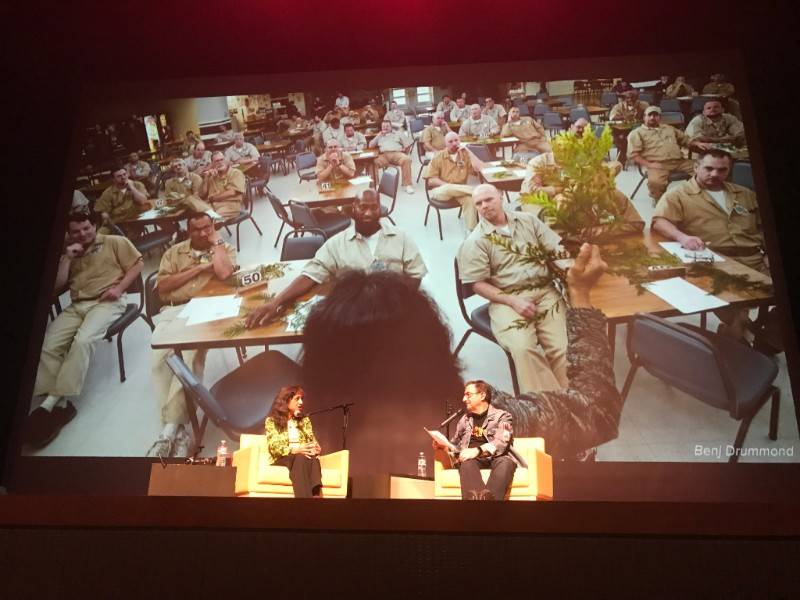
STEMAP Director Nalini Nadkarni had the opportunity to chat with Ira Flatow on NPR’s Science Friday. Ira asked about Nalini’s work in the canopy forests of Costa Rica and how she initially became interested in studying trees. Attendants at the Eccles Theater asked Nalini questions and gained insight about science engagement efforts! Check out the interview here!
STEMAP at NYC Conference
Last month, STEMAP Manager Caitlin Weber attended the SciOut18 meeting at Rockefeller University. The meeting convened scientists, public engagement researchers, and practitioners to reflect on the outcomes and future of the rapidly growing field of public engagement.
Attendees discussed evaluation tools, program goals, sustainability, and strategies to connect with new participants. Caitlin presented STEMAP’s work to extend the reach of engagement by training scientists to engage in non-traditional venues, including cooking classes, correctional facilities, and senior centers.
Public engagement of science is a rapidly evolving field. Gatherings such as SciOut18 play a critical role in building a community of practice. The STEMAP team is thrilled to have been a part of this meeting and looks forward to participating in future gatherings.
Click here for more information about SciOut18.
Nalini Nadkarni at Nat Geo Nights
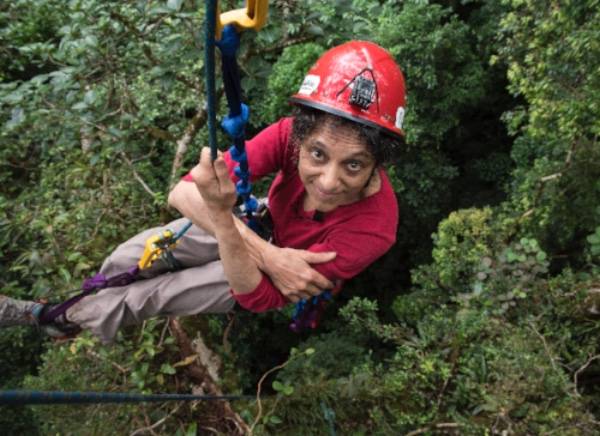
STEMAP Director Nalini Nadkarni joined three other tree canopy scientists at Nat Geo Nights to present their treetop research to a public audience at National Geographic Headquarters in Washington, D.C. In this intimate setting, attendees gathered to socialize before hearing from Nalini and the other National Geographic Explorers!
Welcome Allison Anholt!
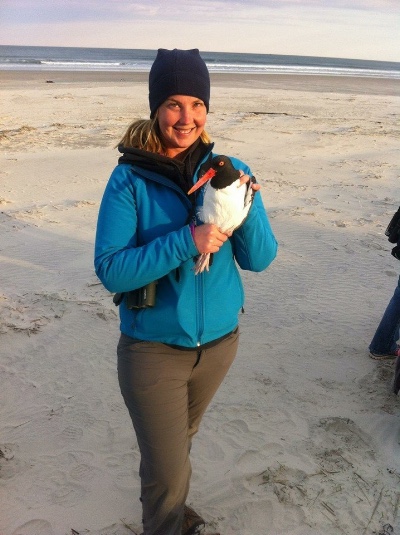
Allison has worked at the intersection of research, community outreach, and citizen science for ten years. She is interested in the ways people decide to devote their passions to the science, in all its forms. Her own scientific “spark” was birds- she’s an avid birder, researcher, and bird bander. A recent East Coast transplant, she has a B.S. in Criminology and Justice Studies from The College of New Jersey and an M.S. in Ecology and Evolution from Rutgers University, where she trained people how to use data to understand and protect endangered species on their beaches.
In the Nadkarni lab, she is working as the Program Manager for the STEMCAP (STEM Community Alliance Program for Youth in Care) and INSPIRE (Initiative to Bring Science to the Incarcerated) programs, where she will be helping to connect scientists with adults and youth in custody to help them find their own “spark!”
STEMAP Online and University of Washington Cohorts
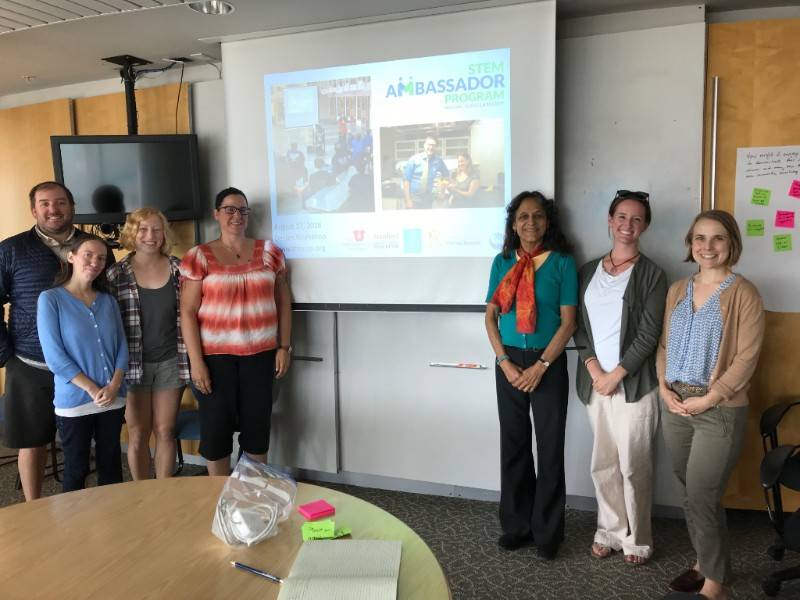
In May of 2018, the STEM Ambassador Program received additional funding to support an online version of STEMAP training. STEMAP put together two cohorts- one entirely-online cohort, recruited with assistance from Friends of Joe’s Big Idea, and one hybrid model facilitated by John Meyer, in the College of the Environment at University of Washington.
Much like the in-person cohort, online participants attended a series of trainings, wrote engagement plans with input from staff, and immersed themselves in their chosen communities.
Members of the first-ever online cohort dealt with the realities of remote work- they collaborated over video conference calls and through email, occasionally ran into technical difficulties and joined conversations from dining halls, boats, and offices.
After training, Ambassadors have completed a variety of events. Some examples:
- Bird ecologist and musician Alice Boyle performed a prairie-themed musical show at a coffee house that linked to stories of her experiences studying birds, the variable weather of great plains, and the ways that humans and animals cope with this environment.
- Ecologist Caitlin Littlefield explored how trees along city streets and in city parks cope with stress. The kids compared those strategies to how humans cope with stress and brainstormed ways in which nature can help us to do so.
- Marine scientist Julie Ann Koehlinger discussed with a local hospital’s “Green Team” how initiatives both save money and protect local waterways. Provided laminated cards that could be used for messaging these positive effects to both hospital employees and patients.
- Public health researcher Celina Valencia visited a rural public library and had a “cafecito“/ coffee talk with local women who are mothers of young children. They discussed the benefits of social support and friendships on improving health outcomes particularly stress associated physiological inflammation.
- Medical researcher Heather Natola went to a sustainable craft store in an economically disadvantaged region of Rochester, NY. While there, she worked with teenagers to show them how their brain processes visual information and turn it into movement by using prism goggles and an electromyography kit.
We are excited to see members of this cohort continue to pursue new and interesting ways to engage with their communities. Thank you to everyone who helped us test a new way of delivering STEMAP!
INSPIRE’s Impact on Correctional Facilities Published in Science Communication
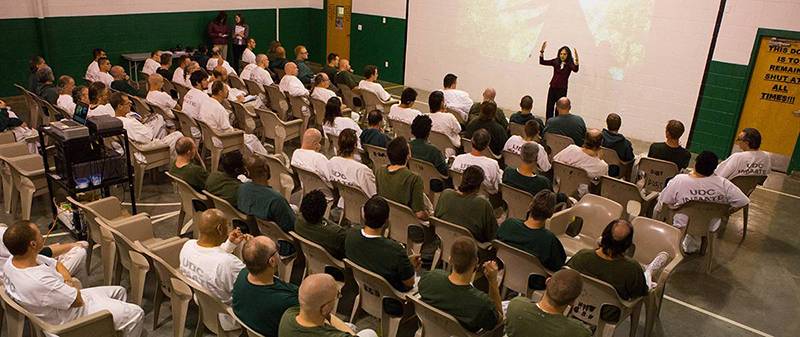
INSPIRE (Initiative to Bring Science to the Incarcerated) has been providing opportunities for inmates to engage in science since 2012. In addition to workshops and conservation projects, INSPIRE features a monthly lecture series where incarcerated men and women are able to attend presentations given by a variety of STEM scientists. Nalini Nadkarni and Jeremy Morris recently published outcomes of the INSPIRE lecture series. See the full report in Science Communication here!
INSPIRE is recruiting scientists to present at Utah’s correctional facilities this spring! If you are interested, please contact Allison Anholt or Meg Young.
Science Communication Course in the 2019 Spring Catalog
Sara Yeo is a professor in the communications department and an active STEM public engagement researcher. Her new graduate course Science and Risk Communication (COMM 7260) explores public opinion formation. Check out the course in the 2019 Spring catalog!
STEM Ambassador Reflections
These articles were written by STEM Ambassadors about their public engagement work. Read on to find out more about Tara Deans’ passport activity with the Pacific Heritage Academy, Cheenu Raghuraman’s presentation on the history and applications of neuroscience, Sarah Apple’s work with Salt Lake senior centers, and our first online Ambassador Alice Boyle interacting with fellow Kansans!
Tara Deans at Pacific Heritage Center

Who is your name? This is how the Tongan and Samoan languages ask your name. The who represents family, and Pacific Islander names are linked to their ancestors. They are rich in culture, have a collective knowledge, intelligence, and curiosity – called mana – that is passed down with stories through generations. Pacific Islander ancestors built canoes, and explored what was beyond their horizon by studying wind patterns, and mapping the sun and stars to discover and inhabit islands in the Pacific Ocean.
I am currently working with the Pacific Heritage Academy, a local title 1 elementary school for my outreach. Along with some amazing U of U volunteers, we conducted an activity called “STEM Journeys” that started with a story of our journeys into our choices for studying STEM fields. Students were given passports, they dressed up as STEM professionals, a picture was taken for their passport, which got filled out as they embarked on their journey in various STEM activities.
Cheenu Raghuraman at Friendly Senior Center
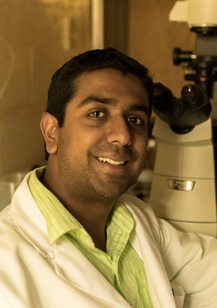
On a fall Friday morning last month, as I stood in a small room with a dozen empty plastic chairs waiting for my audience to show up, many thoughts crossed my mind. “What can I possibly teach someone who has more experience in life than I have?”, I thought to myself, and, “will they even be interested in what I have to say?”. My audience for this science communication event was a group of senior citizens who meet at Friendly Senior Center. As they entered, they looked at the image of the brain that was flashing on the screen.
“The brain huh, we will find out if I have one or not”, chuckled an old lady. “I know my husband didn’t have any”, joked the other. I smiled and introduced myself as a cellular neuroscientist. My goal for this presentation, I said to them, was to give a brief history of neuroscience. I was there to share stories of how philosophers, kings, barbers and a railroad worker contributed to our current understanding of the brain. After 2000 years, we now have a comprehensive brain map that shows how different parts of the brain control different functions. Yet, we don’t know how many different types of cells make up the brain and what happens to each one of them in disease states.
Often, reframing a scientific problem in terms that the audience can relate to makes all the difference. “I want all of you to take a moment and imagine this: If you could catalog all the people in this world, how will you do it?”, I said. There was a moment of silence and I could see the clockwork behind everybody’s eyes (or at least I would like to imagine it). “Based on the gender”, “by geographical location”, “by the language they speak” were few answers. They were now in the right frame of mind to appreciate what I do at work; cataloging neuronal cell types. I explained my research and shared how we are approach this complex problem in our lab. We also discussed the general fear that senior citizens have related to the brain such as Alzheimer’s disease and dementia.
After I finished my presentation, an older woman walked up to me and said, “My son used to talk properly, but after his stroke I had difficulty understanding him. We adopted a new way to communicate with each other now. Do you think brain cells also adapt in similar ways when they suffer from disease?”. I simply hugged her and we chatted for a while about her son and daughter. In the past, I misunderstood science communication as an opportunity to teach science. I considered science communication to be my noble responsibility of imparting knowledge to the general public. But now I have learnt that science communication is an art, where scientists use science as a language to communicate and connect with people.
Sarah Apple at River’s Bend Senior Center
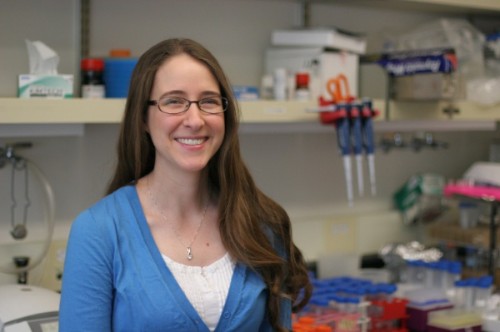
For my last presentation of the summer, I had the opportunity to speak at River’s Bend Senior Center (my third presentation at Salt Lake County Senior Centers!). By speaking at multiple centers this summer I was able to talk to a number of people with different life experiences and outlooks. Each group asked a variety of questions, pushing me to think about different aspects of my research topic and the broader public health implications of bat migration and disease outbreaks opposed to my usual focus on the molecular details of viral infection. After each presentation I would go back and look up some of the questions I did not know the answers to and make sure I had them ready for the next presentation.
Presenting at the Salt Lake County Senior Centers has been truly rewarding for me- seeing people get excited about my research and ask questions about how it could impact their and others’ lives. In addition, listening to the personal stories attendees share about how much science has changed and observing how different groups perceive it is fascinating. I learned that in this more intimate venue my presentations were more successful when I paid special attention to how the audience responded to different concepts. Then I would add additional detail to topics of interest in the moment. Each center has taught me something new and I am grateful for having had the opportunity to present to these audiences.
Alice Boyle and Kaw Creek
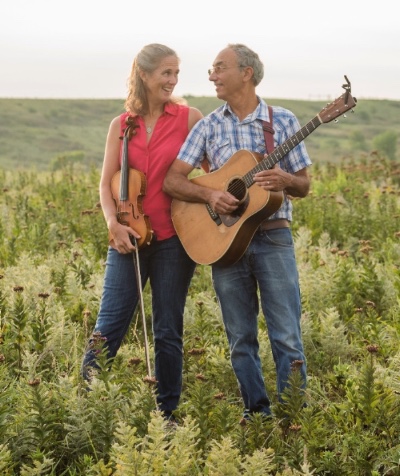
Scientists often have trouble coping with the apparent (and growing?) societal disregard for things we value—truth, understanding, excellence. Even those of us who would like to try to understand other points of view often don’t have opportunities to make genuine connections with people of radically different world views. I am one of the lucky ones. Not only am I a professor in a large state university studying the ways that climate affects the long-term prospects of declining birds in the Great Plains, but I also am a musician. Every year, I spend a week at a large festival in southern Kansas where I camp, laugh, play, and create genuine, deep bonds through music with a cross-section of America—only possible I suspect because the abstract language of music doesn’t obey the divisive rules of political allegiance. I chose to build on the bonds I can develop through music to tell stories of the animals, places, and scientific issues that matter to me. My goals were to engage with a rural Kansans to discuss how weather affects bird populations by drawing links with human livelihoods, and demonstrate that scientists can be people they can trust.
Doing this effectively was a real challenge and more nerve-inducing that doing either science or music alone. Because I wanted to reach people who might be distrustful of scientists and avoid anything “smelling” of science communication, I had to make sure that the music show was great and would be a fun, moving experience all on its own. I researched venues that regularly host live music in parts of Kansas where the people making land-use decisions relevant to the health of prairie bird populations live. I visited some venues and targeted one primarily based on proximity to my home. But I had to have something to market! Although I’ve played with several bands, playing a whole show as a duo (me and my husband) was a new undertaking. We practiced a lot! We thought about how to make the show as varied as possible with just two of us through different combinations of instruments (fiddle, viola, guitar, banjos, uke, and our two voices), different tempos and moods, and mixing recognizable covers with traditional and original pieces. Additionally, we had to do all this within the constraints of a crafting a coherent storyline related to prairies, weather, field work, birds, and the people that live here. To get bookings, we also needed a name, a website, and promotional materials that could lend us some credibility. We drew upon the resources of the university photographer, prior recordings made by our 4-piece band, and boosted our facebook profile through previously-established connections with other musicians in the region.
One of my main concerns was to avoid audiences feeling “tricked” into participating in a science communication event when they just came to enjoy a chill evening of live music. The STEMAP program really helped with this aspect by reminding me that I had defined two distinct goals for the engagement event and encouraging me to make on-the-spot adjustments to my plan based on the composition of the audience and the ways they seemed comfortable interacting. I realized that even if I had to dial back the SciComm to the point where the only real outcome beyond entertainment was to reveal that “scientists are people too,” that outcome was still an important one. At the other end of the spectrum, I was prepared to get children doing prairie-chicken dances to the accompaniment of the Chicken Song, to solicit audience stories about how storms affected them or their livestock in our guestbook or facebook page, and talk about grassland bird declines and the focus of my research.
Our first show was a success. We had an audience of about 40 adults on a weeknight at a coffee shop/book store/community meeting place. The venue handled promotion and we did our own sound. Although every performer notices ways to improve, I was happy with the show from a musical standpoint; we pushed ourselves musically in new ways, but the practice paid off. There were no children so we skipped the chicken dance this time, but included most everything else we planned. The venue made a brief Facebook live video that captures not only one tune set, but me doing an owl imitation beforehand. I don’t think we crossed the line to scientific “preaching”; in fact, next time, I intend to be a bit more explicit with main scientific messages I communicate. Assessment and quantitative feedback is hard at this kind of event, but clear evidence of audience satisfaction came from the tip jar and interest in buying recordings. We plan to keep refining this show and deliver it many times in the coming year or two, reaching as many communities as possible within the remaining extent of original tallgrass prairie in the Flint Hills of Eastern Kansas. Stay tuned…
www.aliceboyle.net; twitter: @birdfiddler; our duo “Kaw Creek” on Facebook
About the Blog
Discussion channel for insightful chat about our events, news, and activities.
Categories
Featured Posts
Tag Cloud
- UoG (2)
- Guam (2)
- ethnobotany (1)
- environmental policy (1)
- student immersion (1)
- engineering (1)
- Virgin Islands (1)
- USVI (2)
- lionfish (1)
- children's home (1)
- conservation (1)
- marine ecology (1)
- youth (1)
- sustainability (2)
- Utah (1)
- Arizona (1)
- Nevada (1)
- southwest (1)
- virtual (1)
- project management (1)
- training (1)
- naturalist (1)
- forest (1)
- ecosystem (1)
- Puerto Rico (1)
- Spanish (1)
- library (1)
- Huntington's (1)
- medical science (1)
- Emmanuel Ngwoke (1)
